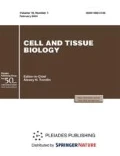Abstract
Nonwoven tubular bioresorbable matrices with an inner diameter of 1.1 mm were obtained by electroforming from solutions of poly (L-lactide) (PLA). Matrices were implanted into the abdominal aorta of rats as a tissue-engineering vascular implant for a period of 2 days to 16 months and showed high biocompatibility, nontoxicity, and pronounced atrombogenic properties. The total implant patency was 93%. Morphometric analysis of the dynamics of population of the matrix with cells showed that, for all observation periods in the outer half of the matrix wall, the number of cells prevails, which indicates the migration of cells from the connective tissue capsule surrounding the matrix. It is shown that two parallel processes occur in the matrix wall: bioresorption of PLA fibers and the formation of connective tissue. Complete bioresorption of matrices with replacement by native tissues, as well as formation of the endothelial and subendothelial layers, took place over the 16 months of the experiment. By this time, all the experimental animals in the reconstruction zone revealed an aneurysmal expansion that did not lead to rupture of the implant. To prevent the development of such complications, it is necessary to develop a method for additional strengthening of the matrix wall.




Similar content being viewed by others
REFERENCES
Acland, R.D., Signs of patency in small vessel anastomosis, Surgery, 1972, vol. 72, pp. 744–748.
Bikbov, B.T. and Tomilina, N.A., The status of substitution therapy for patients with chronic renal failure in the Russian Federation in 1998–2007 (analytical report according to the Russian Register of Renal Replacement Therapy), Nefrol. Dializ, 2011, vol. 13, no. 3, p. 150.
Drews, J.D., Miyachi, H., and Shinoka, T., Tissue-engineered vascular grafts for congenital cardiac disease: Clinical experience and current status. Trends Cardiovasc. Med., 2017, vol. 27, pp. 521–531.
Fukunishi, T., Best, C.A., Sugiura, T., Opfermann, J., Ong, C.S., Shinoka, T., Breuer, C.K., Krieger, A., Johnson, J., and Hibino, N., Preclinical study of patient-specific cell-free nanofiber tissue-engineered vascular grafts using 3-dimensional printing in a sheep model, J. Thorac. Cardiovasc. Surg., 2017, vol. 153, pp. 924–932.
Harskamp, R.E., Lopes, R.D., Baisden, C.E., De, Winter, R.J., and Alexander, J.H., Saphenous vein graft failure after coronary artery bypass surgery: pathophysiology, management, and future directions. Annals Surgery., 2013, vol. 257, pp. 824–833.
Klinkert, P., Post, P.N., Breslau, P.J., and van, Bockel, J.H., Saphenous vein versus PTFE for above-knee femoropopliteal bypass. A review of the literature, Eur. J. Vasc. Endovasc. Surg., 2004, vol. 27, pp. 357–362.
Konig, G., McAllister, T.N., Dusserre, N., Garrido, S.A., Iyican, C., Marini, A., Fiorillo, A., Avila, H., Wystrychowski, W., Zagalski, K., Maruszewski, M., Jones, A.L., Cierpka, L., de la Fuente, L.M., and L’Heureux, N., Mechanical properties of completely autologous human tissue engineered blood vessels compared to human saphenous vein and mammary artery, Biomaterials, 2009, vol. 30, pp. 1542–1550.
L’Heureux, N., Dusserre, N., Konig, G., Victor, B., Keire, P., Wight, T.N., Chronos, N.A., Kyles, A.E., Gregory, C.R., Hoyt, G., Robbins, R.C., and McAllister, T.N., Human tissue-engineered blood vessels for adult arterial revascularization, Nat. Med., 2006, vol.12, pp. 361–365.
Norotte, C., Marga, F.S., Niklason, L.E., and Forgacs, G., Scaffold-free vascular tissue engineering using bioprinting, Biomaterials, 2009, vol. 11, pp. 35–38.
Popryadukhin, P.V., Popov, G.I., Yukina, G.Yu., Dobrovolskaya, I.P., Ivan’kova, E.M., and Vavilov, V.N., Yudin, V.E., Tissue-engineered vascular graft of small diameter based on electrospun polylactide microfibers, Int. J. Biomater., 2017, article ID 9034186. https://doi.org/10.1155/2017/9034186
Row, S., Santandreu, A., Swartz, D.D., and Andreadis, S.T., Cell-free vascular grafts: Recent developments and clinical potential, Technol.(Singap. World Sci.), 2017, vol. 5, pp. 13–20.
Shinoka, T. and Breuer, C., Tissue-engineered blood vessels in pediatric cardiac surgery, Yale J. Biol. Med., 2008, vol. 81, pp. 161–166.
Smith, R.J.Jr., Yi, T., Nasiri, B., Breuer, C.K., and Andreadis, S.T., Implantation of VEGF-functionalized cell-free vascular grafts: regenerative and immunological response, FASEB J., 2019, vol. 33, pp. 5089–5100.
Sullivan, S.J. and Brockbank, K.G.M., Small-diameter vascular grafts, in Principles of Tissue Engineering, New York: Academic, 2000, pp. 447–453.
Tara, S., Kurobe, H., Rocco, K.A., Maxfield, M.W., Best, C.A., Yi, T., Naito, Y., Breuer, C.K., and Shinoka, T., Well-organized neointima of large-pore poly(L-lactic acid) vascular graft coated with poly(L-lactic-co-ε-caprolactone) prevents calcific deposition compared to small-pore electrospun poly(L-lactic acid) graft in a mouse aortic implantation model, Atherosclerosis, 2014, vol. 237, pp. 684–691.
Vaz, C.M., van Tuijl, S., Bouten, C.V., and Baaijens, F.P., Design of scaffolds for blood vessel tissue engineering using a multi-layering electrospinning technique, Acta Biomater., 2005, vol. 1, pp. 575–582.
Watanabe, T., Kanda, K., Ishibashi-Ueda, H., Yaku, H., and Nakayama, Y., Autologous small-caliber ‘‘biotube’’ vascular grafts with argatroban loading: a histomorphological examination after implantation to rabbits, J. Biomed. Mater. Res. B Appl. Biomater., 2010, vol.92, pp. 236–242.
Zhao, Y., Zhang, S., Zhou, J., Wang, J., Zhen, M., Liu, Y., Chen, J., and Qi, Z., The development of a tissue-engineered artery using decellularized scaffold and autologous ovine mesenchymal stem cells, Biomaterials, 2010, vol. 31, pp. 296–307.
Funding
The study was financed by the Russian Science Foundation, project no. 19-73-30003.
Author information
Authors and Affiliations
Corresponding author
Ethics declarations
Conflict of interest. The authors declare that they have no conflict of interest.
Statement on the welfare of animals. Work with animals was carried out in accordance with the rules for the use of experimental animals according to the principles of the European Convention, Strasbourg, 1986 and the Helsinki Declaration of the World Medical Association on the Humane Treatment of Animals, 1996).
Additional information
Abbreviations: TEVI—tissue engineering vascular implant, PLA—poly (L-lactide).
Rights and permissions
About this article
Cite this article
Popov, G.I., Popryadukhin, P.V., Yukina, G.Y. et al. A Morphological Study of a Bioresorbable Tubular Matrix of a Small Diameter from a Poly (L-lactide) for a Tissue-Engineered Vascular Implant. Cell Tiss. Biol. 14, 294–301 (2020). https://doi.org/10.1134/S1990519X20040082
Received:
Revised:
Accepted:
Published:
Issue Date:
DOI: https://doi.org/10.1134/S1990519X20040082




